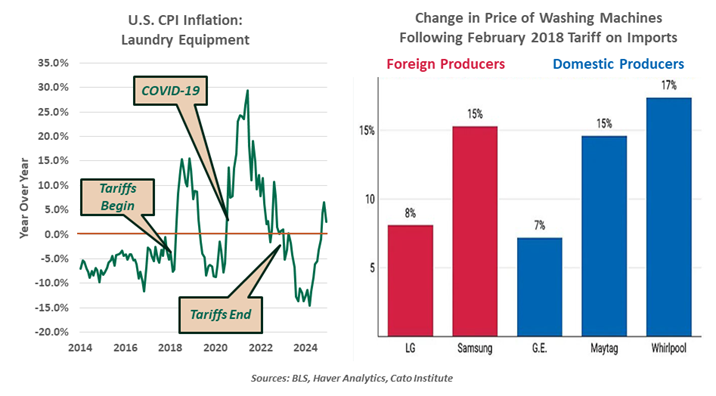- Who We Serve
- What We Do
- About Us
- Insights & Research
- Who We Serve
- What We Do
- About Us
- Insights & Research
Tariffs: A Case Study
The market for washing machines offers lessons for future trade actions.
By Carl Tannenbaum
People are surprised when I tell them that I enjoy doing laundry. Arriving home after traveling, I’ll move quickly to empty my baggage into the hamper and progress the contents to the washing machine. The ritual signals re-entry to my home…and the end of anxiety about whether I have enough clean clothes to last the trip.
You might not think that the laundry room can be a source of economic insight, but I found inspiration there recently. Tariffs have been a hot topic in recent months, and one of the most studied examples of this tactic involves washing machines. That situation illustrates what might be in store if trade restrictions are taken to a new level by the incoming U.S. administration.
No new tariffs were announced in the days after the Presidential inauguration on Monday. But the process of establishing grounds to increase them has started. Virtually all nations have been placed on notice.
The consequences of tariffs have been the subject of considerable speculation. Textbook analysis is clear: any form of trade restraint is likely to increase prices and unlikely to result in much domestic job creation. But predicting specific impacts on prices and employment is not easy.
At a high level, one might observe that tariffs had few consequences during the first Trump administration. Trade restrictions were increased significantly in 2018 and 2019, while the rate of increase in the consumer price index remained stable and employment moved steadily upward. But trends in categories subject to tariffs may have been offset by movements in other areas.
The case study of washing machines does not cast tariffs in a favorable light.
One case study comes close to isolating the impact of tariffs. In January 2018, the U.S. administration imposed additional duties on imported washing machines. The move extended import duties which were first imposed by President Obama in 2013. The Korean manufacturers Samsung and LG were the primary targets.
As economic theory predicts, importers increased their prices to cover the levy. Over the next two years, inflation for washing machines soared. The tariffs produced a level change in the price of washers that evolved gradually. After reaching the new peak, inflation for this category was minimal. The same phenomenon, but in reverse, was seen after the tariffs expired in 2023.
Imports of washing machines fell sharply in the 2018-22 period, but domestic competitors (such as Whirlpool) did not gain much. Samsung and LG built factories in the United States, and kept most of their market share. This was partly due to a decision on the part of American producers to raise their own prices, as opposed to keeping them down to win business from overseas competitors.
The International Trade Commission estimates that 1,800 American jobs were created as a result of the tariffs, at an average annual wage of $47,000. The total cost of the program was estimated to be almost $1.5 billion, or over $800,000 per job created, borne by washing machine buyers. The cost/benefit outcome did not meet expectations.

The specific case of washing machines leads to some general conclusions:
- The impact of tariffs on inflation will develop gradually, and will depend critically on what domestic providers do with their prices.
- Tariffs can create significant costs to consumers. The timing of the impact depends not only on the scale of new levies, but also on how frequently products are purchased. Tariffs on washing machines and vehicles will only be felt intermittently, but measures that affect nondurable products will strike almost immediately.
- Manufacturing is highly automated. Bringing production back home may result in much greater increases in output than employment.
A final, and substantial complication to the analysis of tariffs is the degree to which trade counterparts retaliate. South Korea won a ruling with the World Trade Organization (WTO) against U.S. tariffs, but imposed only minor countermeasures. China, Canada and other countries have already threatened significant reactions to any new American trade restrictions.
As always, the economist answer to questions about tariffs begins with “it depends.” We’ll have to wait until everything comes through the wash to reach firm conclusions.
Related Articles
Read Past Articles
Meet Our Team

Carl R. Tannenbaum
Chief Economist

Ryan James Boyle
Chief U.S. Economist

Vaibhav Tandon
Chief International Economist
Subscribe to Publications on Economic Trends & Insights
Gain insight into economic developments and our latest forecasts for the United States.
Information is not intended to be and should not be construed as an offer, solicitation or recommendation with respect to any transaction and should not be treated as legal advice, investment advice or tax advice. Under no circumstances should you rely upon this information as a substitute for obtaining specific legal or tax advice from your own professional legal or tax advisors. Information is subject to change based on market or other conditions and is not intended to influence your investment decisions.
© 2025 Northern Trust Corporation. Head Office: 50 South La Salle Street, Chicago, Illinois 60603 U.S.A. Incorporated with limited liability in the U.S. Products and services provided by subsidiaries of Northern Trust Corporation may vary in different markets and are offered in accordance with local regulation. For legal and regulatory information about individual market offices, visit northerntrust.com/terms-and-conditions.